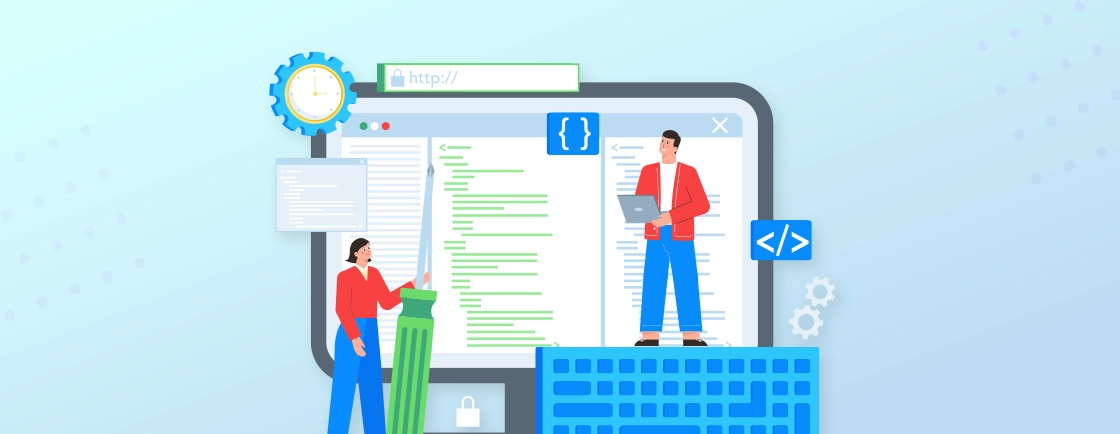Table of Contents
Building a website can feel like navigating a maze. You start with a great vision, but management and collaboration may get you lost. What if there was a better way? Enter Agile, a project management methodology that simplifies development workflow.
In this blog, we will explore common agile web development methodologies, benefits, and key principles to better understand the concept. We will also learn the process web development services follow when using an agile development model. Let’s begin by understanding what agile web development is.
What is Agile Web Development?
Agile is a web development approach to building websites that emphasizes collaboration, flexibility, and continuous improvement. Unlike traditional methods, which follow a linear approach, agile focuses on iterative progress. It ensures the complete web development process is divided into small, manageable tasks called sprints.
Common Agile Methodologies
Agile methodologies are frameworks that follow specific practices to implement Agile principles. Here are some common Agile methodologies used in web development:
- Scrum: Scrum is an Agile framework designed to facilitate complex software development. It emphasizes iterative progress, collaboration, and responding to change. Scrum is characterized by its structured approach to managing work through defined roles, ceremonies, and artifacts.
- Kanban: Kanban is an Agile methodology focused on visualizing work, limiting work in progress (WIP), and maximizing workflow efficiency. Originating from lean manufacturing, it is adaptable to various development processes. It is particularly effective for teams with fluctuating workloads.
- Lean Software Development: Lean Software Development applies lean principles derived from manufacturing to software development processes. It maximizes customer value while minimizing waste, variability, and inefficiencies.
- Extreme Programming (XP): It is an Agile methodology that emphasizes software quality and responsiveness to changing customer requirements. XP practices focus on technical excellence, collaboration, and customer satisfaction.
- Dynamic Systems Development Method (DSDM): DSDM is a rapid prototyping methodology focusing on user involvement and delivering working software. It lets your development process adapt to changing requirements throughout the process.
Choosing the right methodology depends on your project’s needs, team size, and working style. Some projects might benefit from a hybrid approach, combining different methodologies. In the next section, let’s explore the benefits of this approach.
Benefits of Agile Web Development
Agile web development offers a multitude of benefits compared to traditional, more rigid approaches. Here’s a breakdown of some key advantages:
- Faster Time to Market: Agile delivers working features in short sprints, allowing for early user feedback and correction. This iterative process can accelerate the time it takes to launch a website compared to traditional methodology.
- Improved Quality: It focuses on continuous testing and feedback to identify and address issues early on. This leads to a higher-quality website that better meets user needs and expectations.
- Flexibility and Adaptability: It is well-suited for projects with changing requirements. Because the development process is iterative, the team can easily adapt to new priorities or incorporate new features as needed.
- Reduced Costs: Setting up an agile development process may be costly at the initial stage, but it will save money in the long term. It helps you avoid rework and delays associated with traditional methods.
- Reduced Risk: The iterative nature of Agile development allows for course correction along the way. If a particular feature isn’t working out as planned, the team can quickly pivot and adjust their approach. This helps to reduce the risk of project failure.
- Better Scalability: This methodology can be easily scaled to accommodate projects of all sizes. Whether you’re working on a small website or a large enterprise application, Agile can be adapted to fit your needs.
- Improved Teamwork: Collaboration is central to Agile, fostering better communication among development team members. It ensures a more efficient and productive development process.
These benefits make Agile methodology a preferred choice for web developers. It offers a more efficient, responsive, and user-centric approach to building websites. That empowers developers to deliver quality websites quickly.
Key Principles of Agile Web Development
Agile development follows several key principles that serve as the foundation for various frameworks like Scrum and Kanban. Here are the key principles of Agile web development.
Early & Continuous Delivery
It prioritizes delivering usable features to clients frequently, often in cycles of weeks or even days. This ensures that the project remains aligned with the client’s needs so they get value from the development process early. Feedback from these early deliveries can help avoid costly rework later in the development cycle.
Welcome Changing Requirements
Agile methodologies recognize that requirements evolve as projects progress. By evolving with changing requirements, teams can respond effectively to new insights without disrupting the project’s pace. This flexibility enhances the product’s relevance and adaptability to real-world needs.
Deliver Working Software Frequently
This methodology adopts a similar “learn by doing” approach. Instead of waiting for the entire website to be built, teams deliver functional features in short cycles. This allows for early testing, identification of bugs, and quicker feedback loops.
Business & Developers Collaborate Daily
It promotes ongoing collaboration between business stakeholders and development teams throughout the project. Regular interactions ensure a shared understanding of requirements, priorities, and challenges. It also keeps the development efforts aligned with business goals, enhancing value-driven solutions.
Empower Your Team
It thrives in environments where individuals are empowered to make decisions. By creating an inclusive workplace culture, organizations enable team members to achieve project goals. This approach enhances productivity and encourages creative problem-solving.
Face-to-Face Conversation is Key
It prioritizes face-to-face communication to convey information within teams. This approach minimizes misunderstandings and accelerates decision-making processes. Regular meetings ensure that everyone remains informed and aligned.
Continuous Improvement
This means that teams regularly reflect on how the development process works and identify improvement areas. Sprint reviews and retrospectives identify opportunities to improve the development process’s efficiency. By continuously adapting, teams can ensure that they are delivering the highest-quality work possible.
By adopting the above principles, teams can more effectively deliver value to customers. This allows professional web developers to respond quickly and maintain high standards of software quality.
Agile Web Development Process
The Agile web development process is structured around iterative cycles called sprints or iterations. This approach enables teams to deliver incremental improvements to the product, gather feedback, and adjust priorities. Here’s an overview of the process:
Project Initiation and Planning
This initial phase involves gathering requirements, setting project goals, and understanding user needs. Stakeholders and the development team collaborate to create a high-level vision for the project.
- Stakeholder Engagement: Involve stakeholders to gather initial requirements, set project goals, and understand user needs.
- Product Backlog Creation: Compile a list of features, enhancements, bug fixes, and other deliverables, known as the product backlog.
- Team Formation: Assemble a cross-functional team with all the necessary skills to complete the project. It includes developers, designers, testers, and product owners.
A clear understanding of project goals with prioritized backlog will get your development team ready to start work.
Sprint Planning
In this phase, the team plans the work by selecting the highest-priority items from the product backlog.
- Define Sprint Goals: Set clear objectives for the upcoming sprint based on the highest priority items in the product backlog.
- Select Backlog Items: The team selects a set of backlog items to work on during the sprint, ensuring the scope is manageable within the sprint duration.
- Create a Sprint Backlog: Break down the selected backlog items into smaller, actionable tasks. Plus, create a sprint backlog outlining the team’s work.
Here, we defined a sprint backlog with specific tasks and clear sprint goals the team aims to achieve.
Sprint Execution
During the sprint, the team works on the tasks in the sprint backlog. They adhere to Agile practices and conduct daily stand-up meetings to ensure smooth progress.
- Daily Stand-ups: Hold daily meetings where team members discuss their progress plans for the day. This fosters communication, collaboration, and quick problem-solving.
- Task Development: Team members work on the tasks defined in the sprint backlog. It includes practices such as pair programming, test-driven development (TDD), and continuous integration.
- Continuous Testing: Perform regular testing to identify and fix defects early. It ensures the software remains functional and of high quality throughout the sprint.
Here, we completed the sprint backlog with continuous integration and testing. This ensures the software is functional and is of high-quality.
Sprint Review
At the end of the sprint, the team showcases the completed work to stakeholders and gathers feedback.
- Demonstrate Deliverables: The team presents the work to stakeholders during a sprint review meeting. This includes demonstrating new features, enhancements, and bug fixes.
- Gather Feedback: Stakeholders provide feedback on the delivered work, which helps the team understand what needs improvement.
Stakeholder feedback on the delivered work, helps to refine and prioritize future work based on their expectations.
Iterative Development
The process repeats with the next sprint, incorporating feedback and improvements identified during the previous sprint. The product evolves iteratively, with each sprint building upon the last.
Release Planning and Deployment:
The team plans and prepares for deploying completed features to a production environment ensuring they meet quality standards.
- Prepare for Release: Plan and prepare to deploy completed features to a production environment, ensuring they are tested and meet quality standards.
- Deploy Incrementally: Release software updates incrementally, allowing users to regularly benefit from new features and improvements.
By deploying new software updates that deliver enhanced features, we can improve user experience incrementally.
Continuous Feedback and Adaptation:
The team monitors the software in production, gathers feedback, and makes necessary adjustments.
- Monitor and Adjust: Continuously monitor the software in the production, gather user feedback, and make necessary adjustments to meet requirements.
- Refine Backlog: Update and reprioritize the product backlog based on user feedback, market changes, and new insights.
A product that adapts and improves based on feedback meets user needs and stays relevant in the market.
This process emphasizes flexibility, collaboration, and continuous improvement. Hire web developers who can deliver high-quality final products by working in short, iterative cycles. They also help your product in a way that aligns with user needs and your business goals.
What Tools are Commonly Used in Agile Web Development?
Agile web development thrives on a combination of the right tools and techniques to facilitate collaboration and manage tasks. Here’s an overview of some popular tools:
Project Management Tools
Project management tools help Agile teams stay organized and efficient. These tools facilitate task creation, assignment, and monitor progress, and collaborate effectively. They often include features for communication, file sharing, and reporting.
Tools: Trello, Jira, Asana, Wrike
Version Control and Collaboration Tools
Version control systems like Git are essential for Agile development. They track changes to code over time, allowing teams to collaborate on development tasks. These tools facilitate branching, merging, and tracking changes in the codebase.
Tools: Git, GitHub, GitLab, Bitbucket
Continuous Integration/Continuous Delivery (CI/CD) Tools
CI/CD tools automate the building, testing, and deployment processes, ensuring that code changes are integrated and delivered efficiently. These tools help maintain code quality and accelerate the release cycle.
Tools: Jenkins, CircleCI, Travis CI, GitLab CI/CD
Testing and Quality Assurance Tools
Testing and QA tools are essential for ensuring the quality and reliability of web applications. These tools support automated testing, bug tracking, and performance monitoring. It helps developers teams identify and resolve issues quickly.
Tools: Selenium, Cypress, Browser developer tools
The specific tools chosen will depend on the size and complexity of the project, team preferences, and budget. If you want to build your site effectively, hire dedicated web developers. Their expertise in various web technologies can provide you with the best web solutions.
Conclusion
Agile web development offers an alternative to traditional website development methodologies. By prioritizing collaboration, continuous improvement, and responsiveness it empowers teams to deliver user-focused websites. While Agile is not a one-size-fits-all solution, its core principles can be adapted to various project scopes and team structures.
By adapting core principles to your project, you can minimize risks and ensure your website remains successful. With continuous user feedback and proper planning, you can make your project perfect for real-world use. To build your site using these methodologies or any other, hire web developers for efficient development.
FAQs About Agile Web Development
Can Agile be used for all types of web development projects?
While Agile is highly adaptable, it may not be suitable for every project. It works best for projects with evolving requirements and the need for frequent feedback. However, some projects with fixed requirements and deadlines might benefit more from traditional methodologies.
How do Agile sprints work?
Agile sprints are time-boxed iterations, usually lasting 1-4 weeks, where specific tasks or features are developed and tested. At the end of each sprint, a potentially shippable product increment is delivered.
What is a product backlog in Agile?
A product backlog is a prioritized list of features, enhancements, and bug fixes the team plans to work on. It serves as the primary input for sprint planning and is updated based on feedback and requirements.
Explore Our Expert Guides
Dive into detailed tutorials, tips, and strategies designed to help you grow, innovate, and solve problems efficiently.





